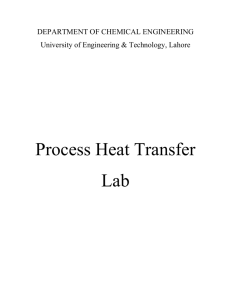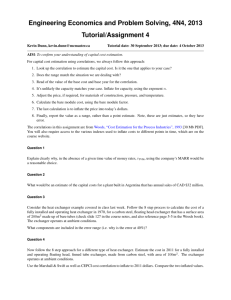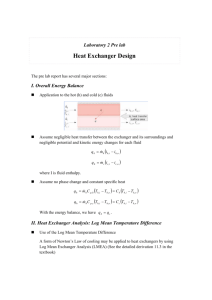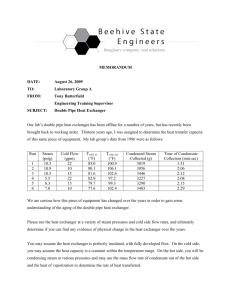Value Optimization in a World of Choices Presenters: Timothy J. Havranek, MBA, PMP
advertisement
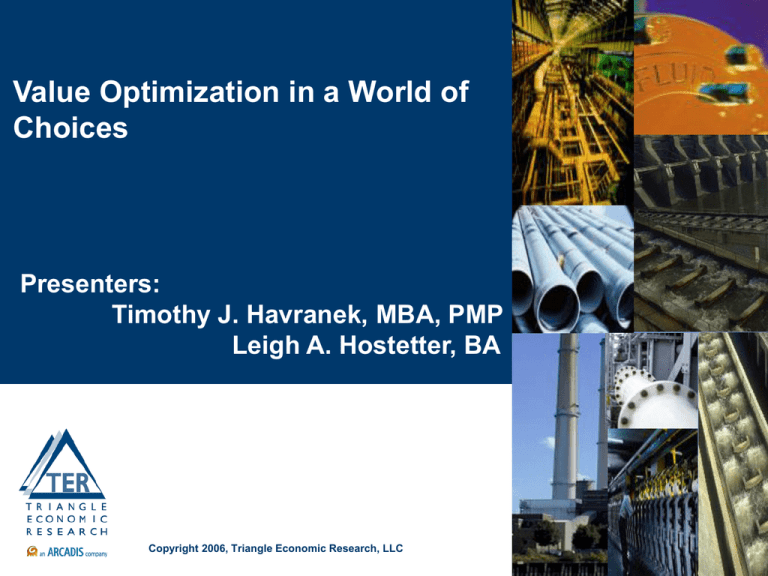
Value Optimization in a World of Choices Presenters: Timothy J. Havranek, MBA, PMP Leigh A. Hostetter, BA Copyright 2006, Triangle Economic Research, LLC DTC Process Framing Meeting Optimization Problem Optimal Decision Modeling Introduction • Client for original model was a chemical manufacturing company • This company has developed a number of value improvement processes (VIPs) – Applied to all new projects – Exist for the each phase – Latter phase VIPs are focused on fine tuning the design • Model developed to facilitate the Design to Capacity (DTC) VIP. DTC Purpose • Maximize capital efficiency • Prevent over design that can occur due to: – Allowances for uncertainty (safety factors) – Equipment and materials come in incremental step sizes – Lack of design definition – Uncertain market demand DTC Approach • Uses a facilitated framing meeting to: – Challenge the design team – Identify design components that add excess capacity and cost – Develop a list of viable alternatives • Alternatives are evaluated in terms of: – Capital and operating costs – Useful equipment life – Manufacturing capacity • Recognizes that costs and equipment life are uncertain Framing Meeting Steps • Identify Major Equipment Alternatives • Provide Equipment Capacities • Develop Cost Range Estimates • Identify Alternative Constraints Major Equipment Requirements • Under the control of the design team • Two or more viable alternatives exist • Equipment could have impact on system capacity Concerns with Standard DTC Process • Assumes that stated design capacity is the optimum capacity • Does not include an evaluation of uncertain demand • Seeks value improvement without addressing “Over the Wall” effect Today’s Presentation • We present the results of a model: – Based on real project – Altered for purposes of demonstration and confidentiality – Evaluates the effect of uncertain demand Optimization and Inputs Optimization: Present Value of Total Cost Present Value of Revenue Net Present Value of Profit System Capacity Capacity Metric - Minimizing Excess Capacity Model Inputs: Product Price Demand Capital Costs Installation Costs Operating Costs Equipment Capacity Equipment Life Framing Meeting Alternatives Alternative Name Alternative Number Primary Cooling System Acid Tower Bottoms Cooler Product Heat Exchanger Water Wash Tower 1 Existing Unit New Shell & Tube Heat Exchanger Existing Fin-Fan Exchanger Monel Clad Tower 2 New Unit Refurbished Fin-Fan Heat Exchanger 3 New Unit with Booster Pump 4 Refurbished Unit New Shell & Tube Carbon Steel Extra Exchanger Corrosion Allowance *Failure of existing unit for the primary cooling system reverts to a refurbished unit **Failure of existing fin fan exchanger for the product heat exchanger reverts to a refurbished fin fan exchanger Model Inputs bbl/day Design Capacity 2,700 Model Assumptions number number percent Working Working Nominal Gallons in Days Per Weeks Per Discount BBL Week Year Rate 55 5 44 12% number Primary Cooling System bbl/day percent years Inflation Rate Economic Horizon 3.5% 20 Capital Cost thousands of dollars Most Max Distribution Likely Capacity Min Existing Unit 2,481 $200 $250 $350 New Unit 3,800 $1,700 $3,500 New Unit with Booster Pump 4,000 $2,500 Refurbished Unit 2,630 $750 Installation Cost thousands of dollars Min Most Likely Max Distribution $258 $0 $0 $0 $0 $5,000 $3,450 $1,000 $1,500 $2,000 $1,500 $4,000 $6,500 $4,167 $1,000 $1,500 $2,000 $1,500 $1,500 $3,000 $1,625 $1,000 $1,500 $2,000 $1,500 Base Product Demand (bbl/day) Most Min Max Distribution Likely 2,400 2,700 3,000 2,700 Base Product Price (per gallon) Min Most Likely Max Distribution $0.35 $0.45 $0.55 $0.45 Input Distributions Distribution for Capital Cost of Existing Primary Cooling System Unit 5.0% 180 200 220 95.0% 240 260 280 Thousands of Dollars 300 320 340 360 Modeling Elements Alternative 1 2 3 4 Primary Cooling System 0 1 0 0 Alternative 1 2 3 4 Final Acid Tower Bottoms Cooler 1 0 0 0 Product Heat Exchanger Water Wash Tower 1 0 0 0 1 0 0 0 Capital Costs Acid Primary Product Tower Cooling Heat Bottoms System Exchanger Cooler $1,075 $0 $3,450 $3,450 $1,075 $0 Capital Coats After Replacement Water Wash Tower $425 $425 Alternative 1 2 3 4 Final Primary Cooling System Acid Tower Product Bottoms Heat Cooler Exchanger Water Wash Tower $1,075 $1,570 $425 $1,075 $1,570 $425 $3,450 $3,450 (2x2) Product Price 2010 Product Demand 2010 Product Price 2010 1 0.75 Product Demand 2010 0.75 1 Optimization for Lowest Total Cost (Present Value) Equipment Alternative Primary Cooling System New Shell & Tube Heat Existing FinExchanger Fan Exchanger 1 2 Acid Tower Bottoms Product Heat Water Wash Cooler Exchanger Tower Monel Clad Tower New Unit 3 4 System Capacity (bbl/day) 2,600 Capacity Metric 2,100 Restricting Equipment Restricting Alternative Initial Capital Costs Product Heat Exchanger Existing Fin-Fan Exchanger $4.95 Initial Installation Costs $1.71 PV of Operating & Replacement Costs $12.90 PV of Total Costs $19.57 PV of Revenue $104.28 NPV of Profit $84.71 Optimization for Specified Design Capacity Equipment Alternative Primary Cooling System Acid Tower Bottoms Product Heat Water Wash Cooler Exchanger Tower Existing FinFan Exchanger 1 Refurbished Fin-Fan Heat Exchanger 2 Carbon Steel Extra Corrosion Allowance 3 4 Refurbished Unit System Capacity (bbl/day) Capacity Metric 2,600 130 Restricting Equipment Restricting Alternative Initial Capital Costs Product Heat Exchanger Existing Fin-Fan Exchanger $3.32 Initial Installation Costs $1.66 PV of Operating & Replacement Costs $44.84 PV of Total Costs $49.82 PV of Revenue $104.51 NPV of Profit $54.69 Optimization for Minimum Excess Capacity, Maximum PV of Revenue and Maximum NPV of Profit Equipment Alternative Primary Cooling System New Shell & Tube Heat Exchanger 1 2 Acid Tower Bottoms Product Heat Water Wash Cooler Exchanger Tower New Unit Monel Clad Tower New Shell & Tube Exchanger 3 4 System Capacity (bbl/day) Capacity Metric 3,500 300 Restricting Equipment Restricting Alternative Initial Capital Costs Acid Tower Bottoms Cooler New Shell & Tube Heat Exchanger $6.03 Initial Installation Costs $1.84 PV of Operating & Replacement Costs $12.36 PV of Total Costs $20.23 PV of Revenue $117.85 NPV of Profit $97.62 Optimization Comparisons Optimization Number Optimization 1 Optimization 2 Optimization 3 NPV of Total Costs System Capacity (bbl/day) Capacity Metric, NPV of Revenue, NPV of Profit Minimum Value Exact Value Minimum Value, Maximum Value, Maximum Value New Unit Refurbished Unit New Unit New Shell & Tube Heat Exchanger Refurbished Fin-Fan Heat Exchanger New Shell & Tube Heat Exchanger Existing Fin-Fan Exchanger Existing Fin-Fan Exchanger New Shell & Tube Exchanger Monel Clad Tower Carbon Steel Extra Corrosion Allowance Monel Clad Tower System Capacity (bbl/day) 2,600 2,600 3,500 Capacity Metric 2,100 130 300 Restricting Equipment Product Heat Exchanger Product Heat Exchanger Acid Tower Bottoms Cooler Restricting Alternative Existing Fin-Fan Exchanger Existing Fin-Fan Exchanger New Shell & Tube Heat Exchanger Initial Capital Costs $4.95 $3.32 $6.03 Initial Installation Costs $1.71 $1.66 $1.84 PV of Operating & Replacement Costs $12.90 $44.84 $12.36 PV of Total Costs $19.57 $49.82 $20.23 PV of Revenue $104.28 $104.51 $117.85 NPV of Profit $84.71 $54.69 $97.62 Variable Optimized Optimization Criteria Primary Cooling System Acid Tower Bottoms Cooler Product Heat Exchanger Water Wash Tower Net Present Value Statistics NPV of Profit Lowest NPV of Total Cost Specified System Capacity Lowest Excess Capacity, Max Revenue and Profit Mean $84 $54 $97 Standard Deviation $3 $3 $7 5th Percentile $79 $50 $85 25th Percentile $82 $52 $92 50th Percentile $84 $54 $97 75th Percentile $86 $56 $101 95th Percentile $88 $58 $108 Statistic NPV Risk Profiles Distribution for NPV of Profit 100% Probability 80% 60% 40% 20% 0% 40 60 80 100 Millions of Dollars Lowest Total Cost Specified Design Capacity Min Excess Capacity, Max Revenue & Profit 120 NPV Histograms Distribution for NPV of Profit 16% Specified System Capacity 14% Low est Total Costs Probability 12% 10% 8% Low est Excess Capacity Metric, Max Revenue & Profit 6% 4% 2% 0% 40 60 80 Millions of Dollars 100 120 Comparison of Cumulative Profit over Time Curves Cumulative Profit Optimization #2 Optimization #1 Optimization #3 240 Millions of Dollars 190 140 90 40 -10 2007 2010 2013 2016 2019 2022 2025 2008 2011 2014 2017 Year 2020 2023 2026 2009 2012 2015 2018 2021 2024 Summary • RISKOptimizer can be used to improve the value of value improvement processes: – Improves decision making under uncertainty – Encourages synergetic analysis rather than a fall back to business axioms – Helps achieve a shared understanding of business alternatives • @RISK can be used for detailed evaluation of alternatives identified by RISKOptimizer • The effects of uncertain demand and product price must accounted for when attempting to design for maximum capital efficiency


